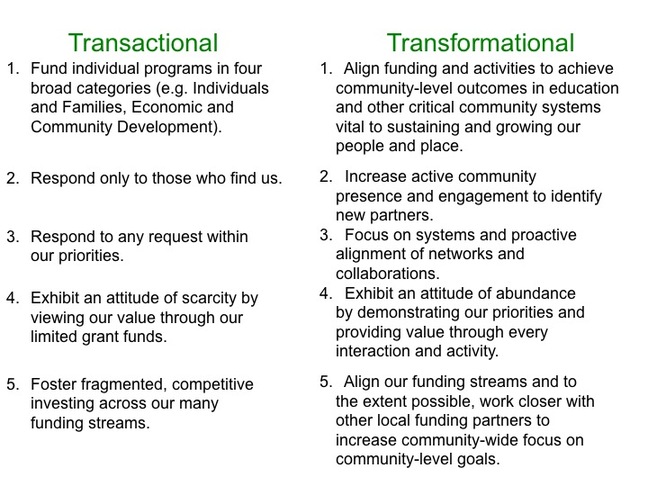
This parsing had elements of time horizon (immediate v. long term) and impact (activities v. structure). But in reality, while source of funding were different, most Community Foundations and United Ways acted similarly to type and use of grant dollars...there was a tendency to spread grant dollars wide and thin. "Let's give all the good people, doing good things, something." What's been most interesting in these past five years is that BOTH local United Ways and Community Foundations have been redefining their roles in the face of growing number of examples of communities getting to solutions. "Give everybody something" has morphed into "give to what gets results."
This reframing proved difficult in practice not only because there was vagueness around what constituted a result, but there was a growing understanding that the very community systems developed to do "good things" were not necessarily the same systems required to get "good results." With Community Foundations designed around the "good things" mechanisms, many were feeling the frustration of "you can't get there from here." It is not surprising, then, that many funders undertook a from ground up rethinking of their purpose and role in getting to good results.
This chart is from one such exploration. It was developed by the Kalamazoo Community Foundation. I'm not presenting it as the only model of this redefinition. But I do think the core redefining point -- from transactional to transformational -- is a very helpful frame.
The implications between a transactional role and a transformational role would be valuable discussion for any Foundation Board Meeting. Let's look at a couple of points of comparison:
1. Fund Individual Programs v. Fund Alignment. There will never be an absence of good ideas in our community space. Social Entreprenurism is the latest expression of this truism. The harder, more demanding task is requiring that these actions get us to a successful result. We have invested billions of dollars on good intentions in our communities across North America. Can we afford to continue to be less demanding as to result than we are in almost every other aspect of our lives?
2. Engage the entire community. Community members are only unusual suspects from the point of view of traditional involvement in the activities of assistance. From the point of view of behavior change and sustainable outcomes, they are the central constituent. Working Differently requires that shift in perspective - in ownership. The art of these cross-sectoral movements is in tapping into the mutuality of benefit that can motivate us all -- in our context -- to align our work.
A valuable additional source for consideration would be our blog entry for Catalytic Leadership. Do your own analysis. What are the implications for your Foundation to move in this direction? What are the implications of not?
To be tweeted links to my new posts -- blog, book reviews (both nonfiction and fiction), data or other recommended tools -- either go to Twitter.com and follow me @jcrubicon, or just go to my Home page and click on the Twitter button on the right, just above the tweet stream, and follow me @jcrubicon.
 RSS Feed
RSS Feed
